The McDonnell Douglas DC-10, a trijet airliner that once dominated the skies, is now a rare sight. But how many DC-10s are still flying as of 2024? Flyermedia.net delves into the current status of this iconic aircraft, highlighting the specific roles and operators that keep a handful of these magnificent planes airborne. We aim to provide aviation enthusiasts and industry professionals with an accurate picture of the DC-10’s presence in today’s aviation landscape, exploring their cargo operations, specialized roles, and potential sightings.
1. What Is The Current Operational Status of DC-10 Aircraft?
Currently, only a limited number of DC-10 aircraft remain operational, primarily serving as freighters or in specialized roles like aerial firefighting and flying hospitals. These aircraft, originally designed for long-range, high-capacity passenger travel, have transitioned to niche applications where their unique capabilities are still valued. The retirement of the KC-10A Extender by the United States Air Force further reduced the number of active DC-10s worldwide. Let’s delve deeper into this topic.
The McDonnell Douglas DC-10 was first introduced in 1971, which met the demands of the long-range and high-capacity travels. It was positioned between the wide-body giants and smaller jets during its era. The plane was known for its distinctive trijet layout, with two engines under the wings and one integrated into the tail. The DC-10 was a popular choice for both passenger and cargo transport due to its range, load capabilities, and suitability for a number of purposes. Throughout its commercial life, the DC-10 was operated by airlines worldwide, including American Airlines, United Airlines, and KLM.
Despite a troubled start due to a series of high-profile incidents in the 1970s, the DC-10 eventually gained a strong reputation for reliability, especially in cargo operations. After McDonnell Douglas ceased production in 1989, many DC-10s continued flying in freighter roles, with some retrofitted as the MD-10 in partnership with FedEx, offering an updated cockpit. The KC-10A Extender, a refueling and transport variant flown by the United States Air Force, was also one of the DC-10’s most enduring roles.
According to research from Embry-Riddle Aeronautical University, the operational lifespan of aircraft like the DC-10 depends heavily on maintenance, utilization, and regulatory factors.
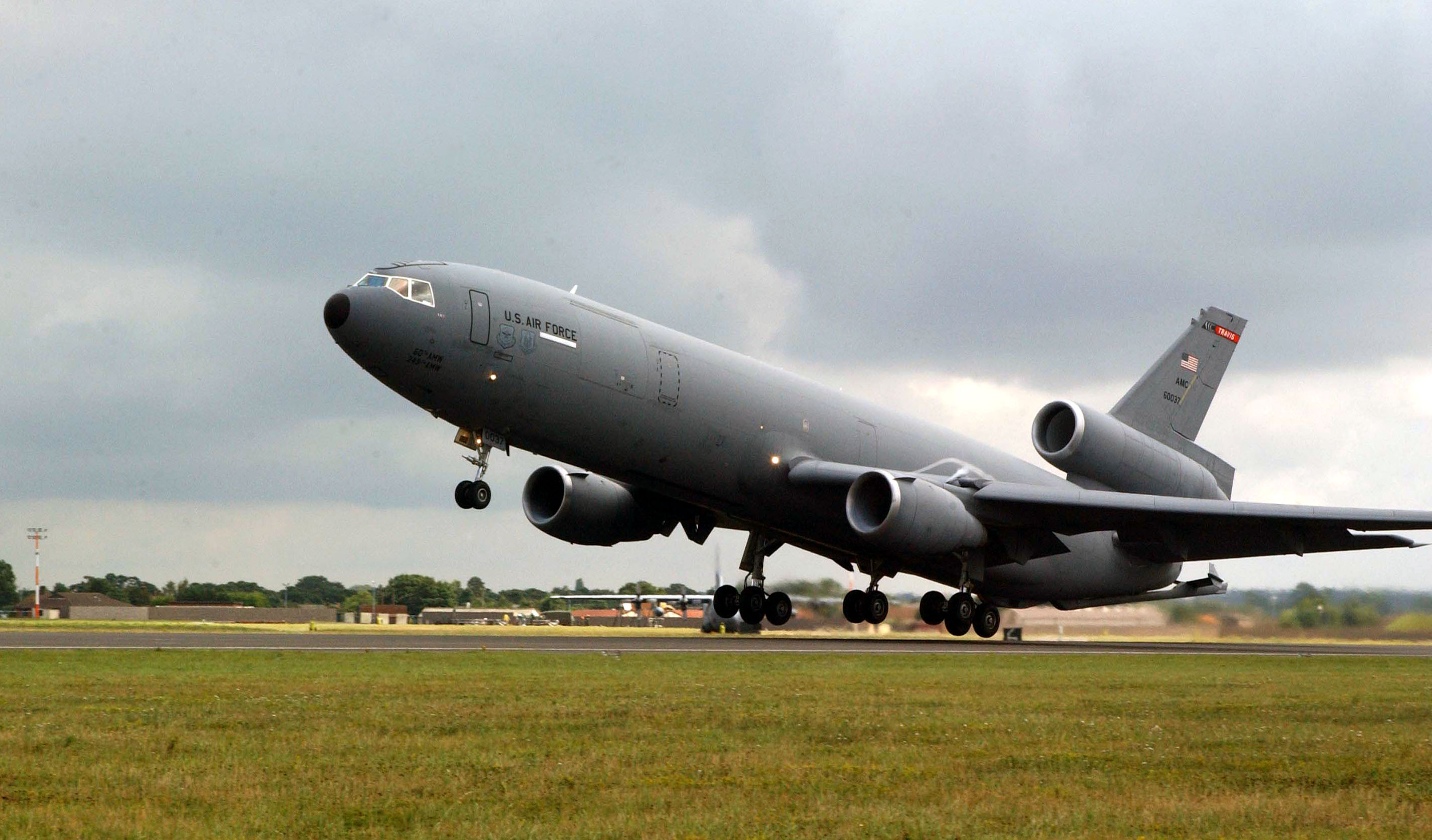 USAF KC-10
USAF KC-10
1.1. What Factors Contributed to the Decline in Active DC-10s?
Several factors have contributed to the decline in active DC-10s, including:
- Aging Fleet: As the DC-10 design dates back to the 1960s, the airframes of the remaining aircraft are aging, requiring more frequent and extensive maintenance.
- Fuel Efficiency: Newer aircraft designs offer better fuel efficiency, making them more attractive to airlines looking to reduce operating costs.
- Regulatory Changes: Evolving aviation regulations and safety standards can make it more challenging and expensive to keep older aircraft like the DC-10 in service.
- Retirement of KC-10A: The retirement of the KC-10A Extender by the U.S. Air Force significantly reduced the number of active DC-10s. The Air Force retired its last KC-10A, marking the end of an era for the DC-10 in military service and contributing to the significant decline in active DC-10s worldwide. The type flew its final flight on 26 September 2024, with examples being sent to museums or long term storage.
1.2. How Are the Remaining DC-10s Being Used?
The remaining DC-10s are primarily used in the following roles:
- Cargo Freighters: Many DC-10s have been converted into freighters, carrying cargo for airlines and logistics companies.
- Aerial Firefighting: Specially modified DC-10s are used as air tankers to drop fire retardant on wildfires.
- Aerial Refueling: Some DC-10s are still used for aerial refueling, providing fuel to other aircraft in flight.
- Flying Eye Hospital: One unique DC-10 has been converted into a flying eye hospital, providing medical care to people in remote areas.
2. Which Cargo Airlines Still Operate The DC-10?
Several cargo airlines around the world continue to operate the DC-10, primarily for its large cargo capacity and suitability for long-haul flights. These airlines often utilize the DC-10 for routes where newer, more fuel-efficient aircraft may not be as practical or cost-effective.
2.1. Cargo Three
This Panamanian cargo airline operates a single DC-10 aircraft as a freighter. It is actually a former FedEx MD-10 example, with the registration HP-1755CTW, and is based at Panama City Pacifico International.
The airline has two other MD-10s it plans to bring into service.
2.2. TAB Airlines
Transportes Aéreos Bolivianos, or TAB Airlines, is a cargo carrier based in Bolivia. It has a former FedEx MD-10-30 freighter in service, which can often be seen flying into Miami, FL.
It has the registration CP-2791.
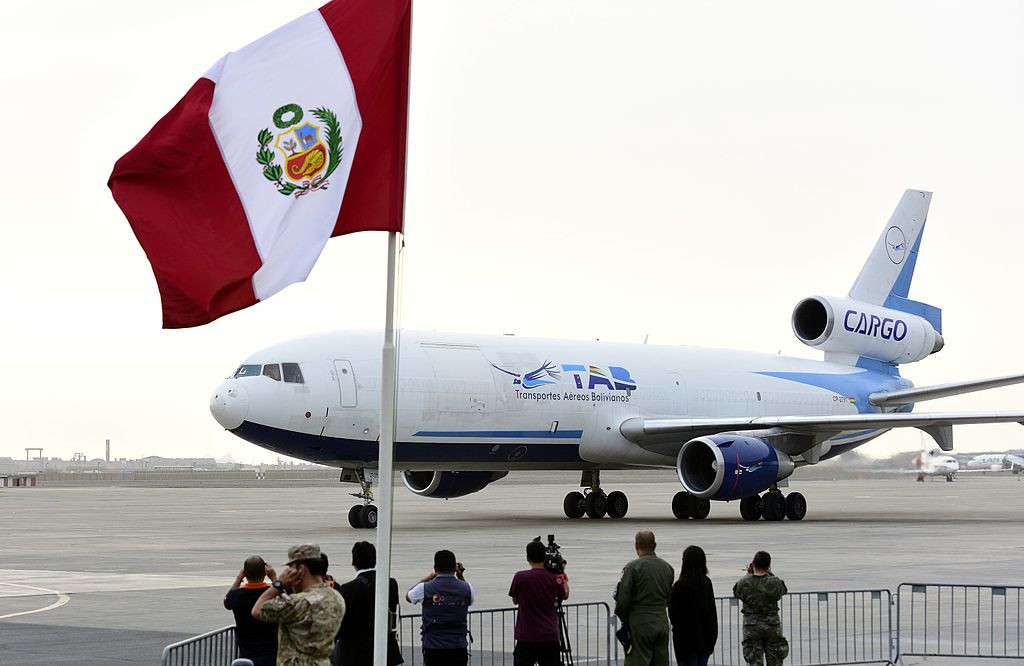 TAB Airlines DC-10
TAB Airlines DC-10
2.3. What Are The Advantages of Using DC-10s for Cargo Operations?
- Large Cargo Capacity: The DC-10 has a large cargo capacity, making it suitable for carrying large volumes of goods.
- Long Range: The DC-10 has a long range, allowing it to fly long distances without refueling.
- Cost-Effectiveness: For certain routes and operations, the DC-10 can be a cost-effective option compared to newer aircraft.
- Proven Reliability: Despite its age, the DC-10 has a proven track record of reliability, especially in cargo operations.
3. Who Is Omega Air, And What Is Their Role With The DC-10?
Omega Air is an aerial refueling specialist that operates three DC-10 tankers, providing aerial refueling services to military and commercial customers. These DC-10s are equipped with specialized refueling equipment and are used to extend the range and endurance of other aircraft in flight.
Omega Air operates three DC-10 tankers. They are N235UL, N264DE and N974VV. The latter is the only flying example of a DC-10-40 and previously flew for Japan Airlines. The other two started life with Martinair Holland.
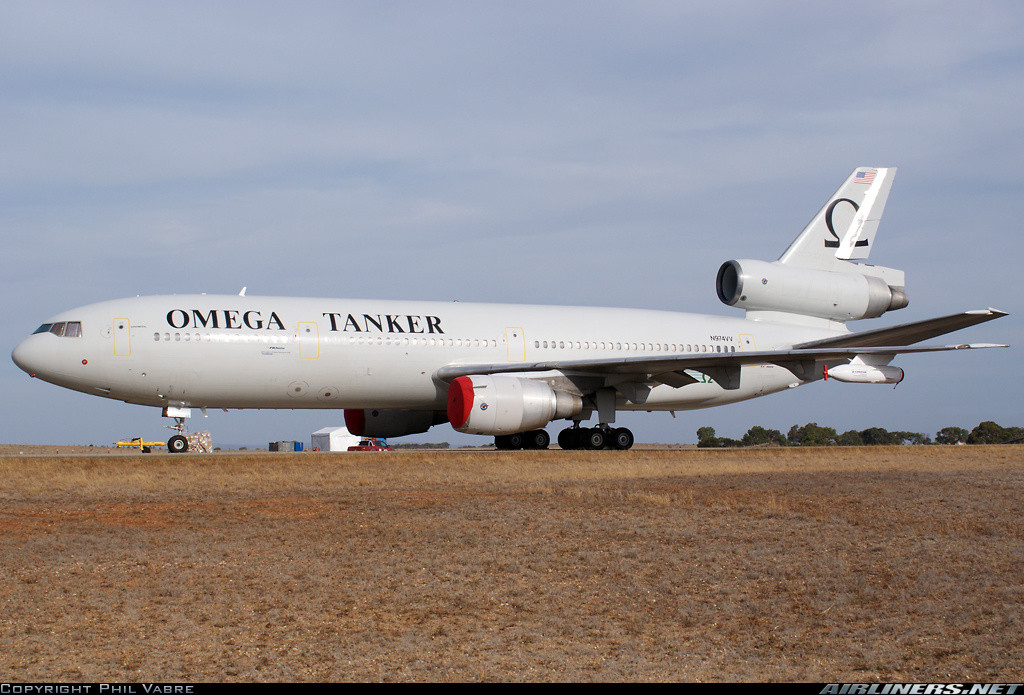 Omega Air DC-10
Omega Air DC-10
3.1. What Is Aerial Refueling, And Why Is It Important?
Aerial refueling, also known as air-to-air refueling (AAR), is the process of transferring fuel from one aircraft (the tanker) to another (the receiver) during flight. This allows the receiver aircraft to remain airborne for longer periods, extending its range and endurance. Aerial refueling is critical for military operations, allowing fighter jets, bombers, and transport aircraft to reach distant targets or remain on station for extended periods. It is also used in commercial aviation to extend the range of passenger and cargo flights.
3.2. What Modifications Are Required to Convert a DC-10 Into an Aerial Refueling Tanker?
Converting a DC-10 into an aerial refueling tanker requires several modifications, including:
- Installation of Refueling Equipment: The aircraft must be equipped with refueling pods or booms, which are used to transfer fuel to the receiver aircraft.
- Fuel Tank Modifications: Additional fuel tanks may be installed to increase the aircraft’s fuel capacity.
- Structural Reinforcements: The aircraft’s structure may need to be reinforced to support the additional weight of the refueling equipment and fuel.
- Avionics Upgrades: The aircraft’s avionics systems may need to be upgraded to support the refueling mission.
4. What Is 10 Tanker Air Carrier’s Role In Firefighting With The DC-10?
10 Tanker Air Carrier is a company that operates four DC-10-30 aircraft as air tankers, providing aerial firefighting services to combat wildfires. These DC-10s are equipped with large tanks that can carry thousands of gallons of fire retardant, which is dropped over wildfires to help contain and extinguish the flames.
One of the most specialist roles the DC-10 has been called to operate is that of airborne firefighting unit, and 10 Tanker Air Carrier of California has four DC-10-30 examples in service. These are modified airliners which now carry large quantities of fire retardant which is dropped over wildfires.
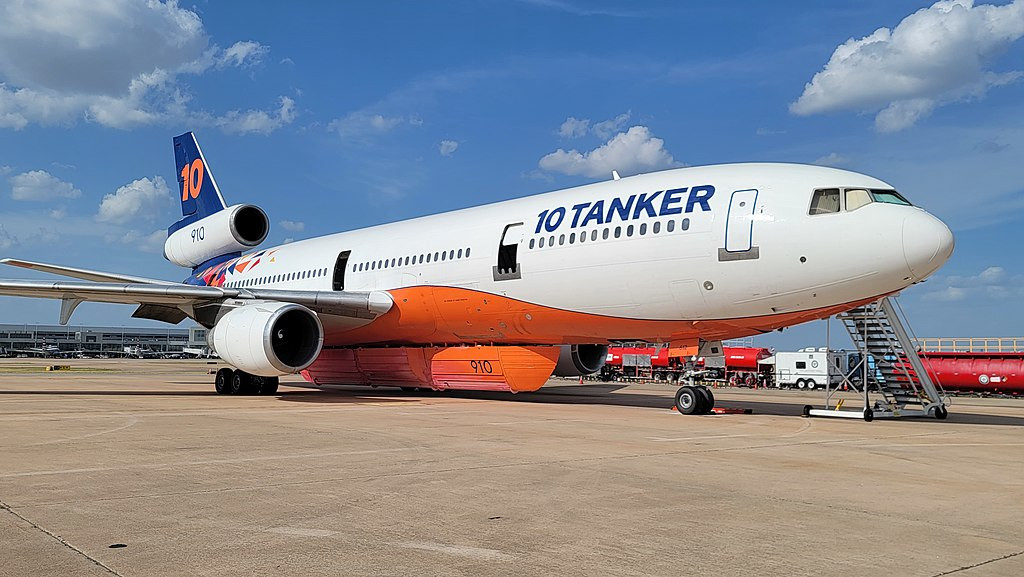 DC-10 Tanker 910 Parked at AUS
DC-10 Tanker 910 Parked at AUS
4.1. How Effective Are DC-10s in Fighting Wildfires?
DC-10s are highly effective in fighting wildfires due to their:
- Large Capacity: DC-10s can carry a large volume of fire retardant, allowing them to cover a large area with a single drop.
- Speed and Range: DC-10s can travel quickly to reach wildfires and have a long range, allowing them to operate in remote areas.
- Precision Delivery: DC-10s are equipped with advanced delivery systems that allow them to accurately drop fire retardant on the target area.
4.2. What Are the Challenges of Using DC-10s in Firefighting Operations?
While DC-10s are effective in fighting wildfires, there are also some challenges associated with their use:
- Operating Costs: DC-10s are expensive to operate, requiring significant fuel and maintenance costs.
- Airfield Requirements: DC-10s require long runways and specialized facilities, limiting the number of airfields from which they can operate.
- Weather Restrictions: DC-10s cannot operate in all weather conditions, such as high winds or low visibility.
5. Project Orbis: How Is The DC-10 Used As A Flying Eye Hospital?
Project Orbis operates a single MD-10 aircraft as a flying eye hospital, bringing much-needed medical support and eye care to people in the poorest regions around the world. This MD-10 is equipped with a state-of-the-art operating room, laser treatment room, and recovery room, allowing doctors to perform life-saving eye surgeries and treatments on board.
This MD-10, N330AU, previously flown by FedEx as a freighter, now has surgeries and medical equipment on board where doctors can perform lifesaving eye surgeries and treatments.
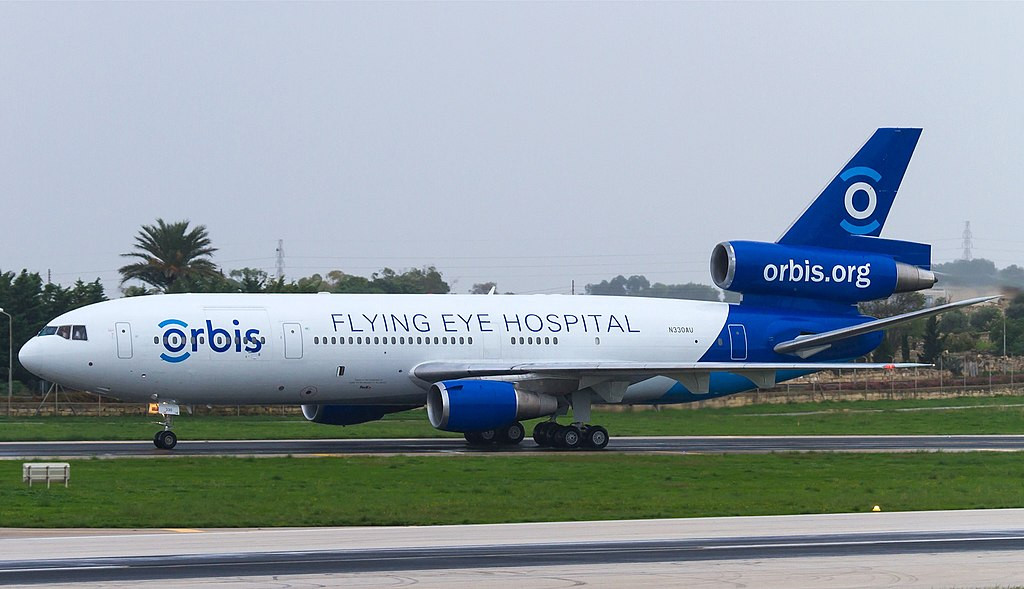 ORBIS Flying Eye Hospital McDonnell Douglas MD-10-30F N330AU LMML Cn 46800 Cropped
ORBIS Flying Eye Hospital McDonnell Douglas MD-10-30F N330AU LMML Cn 46800 Cropped
5.1. What Types of Medical Procedures Are Performed Onboard the Orbis Flying Eye Hospital?
The Orbis Flying Eye Hospital performs a wide range of medical procedures, including:
- Cataract Surgery: Removing cataracts and restoring vision.
- Corneal Transplants: Replacing damaged corneas with healthy tissue.
- Glaucoma Surgery: Reducing pressure in the eye to prevent vision loss.
- Strabismus Surgery: Correcting misaligned eyes.
- Pediatric Eye Care: Providing eye care to children, including screenings, treatments, and surgeries.
5.2. How Does Project Orbis Benefit Communities in Need?
Project Orbis benefits communities in need by:
- Providing Access to Eye Care: Bringing eye care services to remote areas where they are not readily available.
- Training Local Doctors: Training local doctors and nurses in advanced eye care techniques.
- Raising Awareness: Raising awareness about the importance of eye care and preventing blindness.
6. Where Can Aviation Enthusiasts Still See A DC-10?
Aviation enthusiasts eager to see a DC-10 can still find them at some museums around the world, or in long-term storage. While the number of active DC-10s is declining, many have been preserved in museums or are stored in various locations, offering opportunities for enthusiasts to see these iconic aircraft up close.
6.1. Which Museums Have DC-10s On Display?
Several museums around the world have DC-10s on display, including:
- Pima Air & Space Museum (Tucson, Arizona, USA): This museum has a DC-10-10 on display, which was previously operated by Continental Airlines.
- National Museum of the United States Air Force (Dayton, Ohio, USA): This museum has a KC-10A Extender on display, which was retired from the U.S. Air Force.
- Delta Flight Museum (Atlanta, Georgia, USA): This museum has a DC-10-30 on display, which was previously operated by Delta Air Lines.
- Science Museum Oklahoma (Oklahoma City, Oklahoma, USA): This museum has a DC-10 flight simulator on display, which allows visitors to experience what it is like to fly a DC-10.
6.2. What Are Some Tips for Spotting a DC-10 at an Airport?
- Check Airport Spotting Websites: Websites like FlightAware and Flightradar24 can be used to track the movements of aircraft, including DC-10s.
- Visit Airports Known for Cargo Operations: Airports that handle a lot of cargo traffic are more likely to have DC-10s operating there.
- Attend Airshows and Aviation Events: Airshows and aviation events sometimes feature DC-10s on static display or in flight demonstrations.
- Join Aviation Enthusiast Groups: Aviation enthusiast groups can provide information about DC-10 sightings and events.
7. What Is The Significance of The DC-10 In Aviation History?
The DC-10 holds a significant place in aviation history as one of the first wide-body trijet airliners, introducing new levels of passenger capacity and range to commercial aviation. Despite its early challenges, the DC-10 played a crucial role in connecting people and cultures around the world, and its legacy continues to be felt today.
7.1. What Were Some of The Key Innovations Introduced by The DC-10?
- Wide-Body Design: The DC-10 was one of the first wide-body airliners, offering more space and comfort for passengers.
- Trijet Configuration: The DC-10’s trijet configuration, with one engine in the tail, was a unique design that offered both performance and efficiency.
- Advanced Avionics: The DC-10 was equipped with advanced avionics systems, including an autopilot and an inertial navigation system.
7.2. How Did The DC-10 Impact Air Travel?
- Increased Passenger Capacity: The DC-10’s large passenger capacity made air travel more accessible and affordable for many people.
- Expanded Route Networks: The DC-10’s long range allowed airlines to offer new routes and connect distant cities.
- Improved Comfort: The DC-10’s spacious cabin and comfortable seating made air travel more enjoyable for passengers.
8. What Is The Difference Between The DC-10 and The MD-10?
The MD-10 is an upgraded version of the DC-10, primarily featuring a modernized cockpit with a two-person crew, as opposed to the DC-10’s three-person crew. This upgrade, often performed in partnership with FedEx, improved the aircraft’s efficiency and reduced operating costs.
8.1. What Were The Main Upgrades Included in The MD-10 Conversion?
- Advanced Cockpit: The MD-10 featured an advanced cockpit with a two-person crew, reducing the workload for pilots and improving efficiency.
- Electronic Flight Instrument System (EFIS): The MD-10 was equipped with an EFIS, which provided pilots with more accurate and reliable flight information.
- Improved Automation: The MD-10 had improved automation systems, reducing the need for manual input from pilots.
8.2. How Did The MD-10 Conversion Affect The Aircraft’s Performance?
The MD-10 conversion had a positive impact on the aircraft’s performance, including:
- Reduced Operating Costs: The two-person crew reduced labor costs, making the aircraft more cost-effective to operate.
- Improved Fuel Efficiency: The advanced cockpit and improved automation systems helped to improve fuel efficiency.
- Increased Reliability: The modernized systems and components improved the aircraft’s reliability.
9. What Were The Safety Concerns And Incidents Associated With The DC-10?
The DC-10 had a troubled start due to a series of high-profile incidents in the 1970s, which raised concerns about its safety. These incidents led to design changes and improved maintenance procedures, which ultimately improved the aircraft’s safety record.
9.1. What Were Some of The Most Notable DC-10 Accidents?
- Turkish Airlines Flight 981 (1974): This accident, which occurred near Paris, France, was caused by a faulty cargo door that opened in flight, leading to a rapid decompression and the loss of the aircraft.
- American Airlines Flight 191 (1979): This accident, which occurred in Chicago, Illinois, was caused by a structural failure of the engine pylon, leading to the loss of the engine and the subsequent crash of the aircraft.
- United Airlines Flight 232 (1989): This accident, which occurred in Sioux City, Iowa, was caused by a failure of the tail-mounted engine, leading to a loss of control of the aircraft.
9.2. How Did These Incidents Impact The DC-10’s Reputation?
These incidents had a negative impact on the DC-10’s reputation, leading to:
- Loss of Public Confidence: The public lost confidence in the safety of the DC-10, leading to a decline in passenger bookings.
- Regulatory Scrutiny: The DC-10 came under increased scrutiny from aviation regulators, who ordered design changes and improved maintenance procedures.
- Financial Losses: The accidents and the resulting loss of public confidence led to financial losses for McDonnell Douglas and the airlines that operated the DC-10.
10. What Are Some Interesting Facts About The DC-10?
The DC-10 is a fascinating aircraft with a rich history, and there are many interesting facts about it that aviation enthusiasts may appreciate. From its unique design to its diverse roles, the DC-10 has left an indelible mark on the aviation industry.
10.1. Did You Know the DC-10 Was Originally Designed To Compete With The Boeing 747?
The DC-10 was originally designed to compete with the Boeing 747, offering a smaller and more fuel-efficient alternative for long-range routes. While the 747 became the dominant wide-body airliner, the DC-10 found its niche in serving routes that didn’t require the 747’s massive capacity.
10.2. Did You Know the DC-10 Was Used To Transport The Space Shuttle?
NASA used a modified Boeing 747, known as the Shuttle Carrier Aircraft (SCA), to transport the Space Shuttle between launch and landing sites. However, the DC-10 was also considered for this role, but the 747 was ultimately chosen due to its greater lift capacity.
10.3. Did You Know the DC-10 Has Appeared in Several Movies and TV Shows?
The DC-10 has appeared in several movies and TV shows, including “Airport 1975,” “Executive Decision,” and “Pushing Tin.” Its distinctive trijet design and wide-body fuselage make it easily recognizable on screen.
10.4. Did You Know the DC-10 Was Nicknamed “The Death Cruiser” by Some Pilots?
Due to its early safety record, the DC-10 was nicknamed “The Death Cruiser” by some pilots. However, after design changes and improved maintenance procedures, the DC-10’s safety record improved significantly.
The McDonnell Douglas DC-10, an iconic aircraft with a rich history, continues to operate in limited numbers around the world. Primarily used for cargo operations, aerial firefighting, and specialized roles like the Orbis Flying Eye Hospital, the DC-10 remains a testament to aviation engineering.
For those passionate about aviation and eager to explore more about aircraft like the DC-10, flyermedia.net offers a wealth of information. Whether you’re seeking pilot training programs, the latest aviation news, or career opportunities in the field, flyermedia.net is your go-to resource.
Ready to take your aviation journey to new heights? Visit flyermedia.net today to discover a world of aviation possibilities. Explore our pilot training programs, stay updated with the latest aviation news, and find exciting career opportunities. Your aviation adventure starts here.
FAQ: Frequently Asked Questions About The DC-10
1. What is the maximum speed of a DC-10?
The maximum cruising speed of a DC-10 is approximately 908 km/h (564 mph or Mach 0.82).
2. What is the range of a DC-10?
The range of a DC-10 varies depending on the model, but it typically ranges from 3,800 nautical miles (7,000 km) to 5,200 nautical miles (9,600 km).
3. How many passengers can a DC-10 carry?
The DC-10 can typically carry between 250 and 380 passengers, depending on the configuration.
4. What engines did the DC-10 use?
The DC-10 used three turbofan engines, typically General Electric CF6 or Pratt & Whitney JT9D engines.
5. When was the last DC-10 manufactured?
The last DC-10 was manufactured in 1989.
6. What is the takeoff distance of a DC-10?
The typical takeoff distance of a DC-10 is around 8,500 feet (2,590 meters) at maximum takeoff weight.
7. Is the DC-10 still considered safe to fly?
Yes, the remaining DC-10s are maintained to meet safety standards, and their operations are closely monitored by aviation authorities.
8. What is the typical crew size for a DC-10?
The typical crew size for a DC-10 is three: two pilots and one flight engineer. The MD-10, an upgraded version of the DC-10, operates with a two-pilot crew, eliminating the need for a flight engineer.
9. How many DC-10s were built?
A total of 386 DC-10s were built between 1968 and 1988.
10. What are some of the alternative names that DC-10 is known as?
Some of the alternative names that DC-10 is known as includes McDonnell Douglas DC-10, MD-10, Trijet.